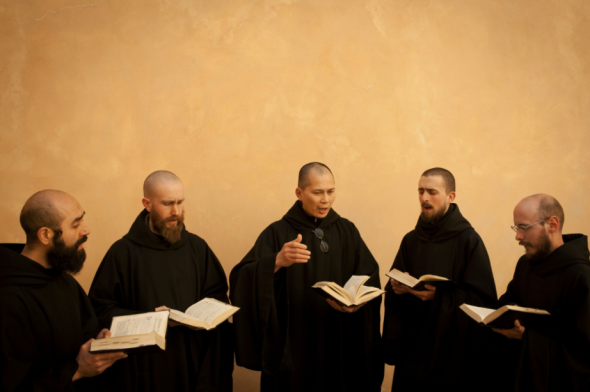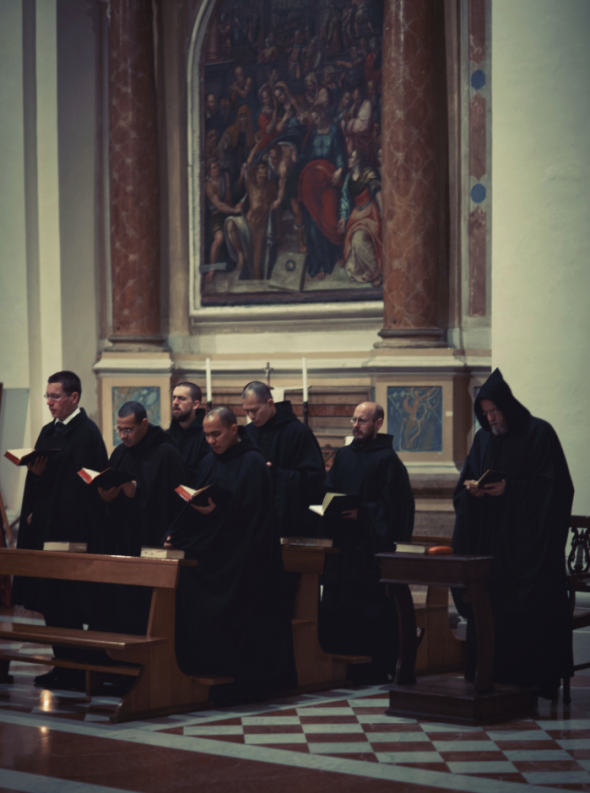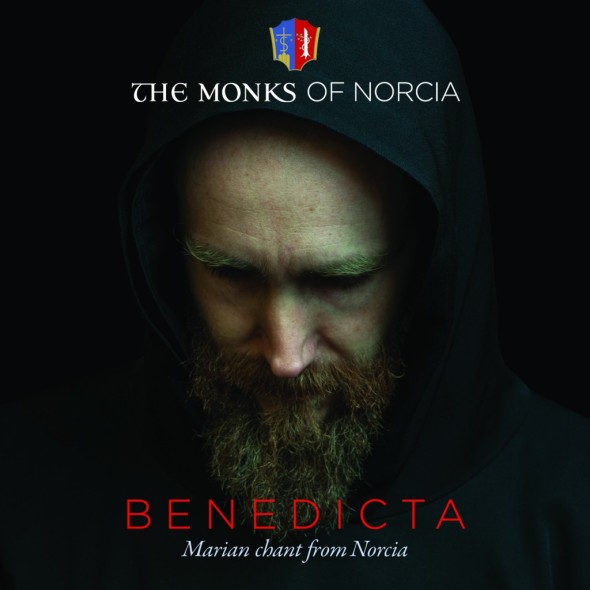Families|June 29, 2015 07:01 EDT
The Young Monks Explain Why They Stay Away From 'Secular' Music While Successfully Climbing the Charts With 'Holy Chant' Songs [INTERVIEW]

The young Monks of Norcia top the charts with their "sacred music." In an in depth interview with Fr. Cassian Folsom, Prior, BREATHEcast got an inside look into the life and music of the young Monks.
On June 2, De Montfort Music together with Decca Classics/Universal Music Classics released BENEDICTA: Marian Chant from Norcia, the major label debut from The Monks of Norcia. Based in Norcia, Italy, the community of the Benedictine Monks of Norcia is comprised of 18 men, half American citizens and the other half a diverse group of men from all over the world representing a variety of cultural backgrounds.
Monks and their devotional singing were not heard in Norcia for nearly 200 years, until 1998 when Fr. Cassian Folsom, Prior, settled with his community back in the birthplace of St. Benedict and The Monks of Norcia were born. The group is now Billboard's No. 1 selling classical group. See out full interview below:
BREATHEcast: You said in your EPK that living the monastic life is very ordinary,
what drew you to that lifestyle?
Fr. Cassian Folsom, Prior: By the end of my freshman year of college, I had narrowed down my vocational choices to two: become a missionary or become a monk. I was powerfully drawn to a life of prayer, and God used the monastic way to draw me to Himself. By Divine Providence, I ended up in a monastery in Italy (secularized Europe is largely mission territory), so the Lord has called me to be both monk and missionary. Monastic life is very ordinary, in the sense that we work by the sweat of our brow just like everyone else, and our daily routine - aside from the liturgical prayer - is rather plain. The challenge is to discover God in the ordinary.
BC: Can you briefly but informatively share your journey to faith with us?
Throughout my life, God has touched me profoundly at certain moments. If I "connect the dots," if I connect those various moments, then I can see the outline and plan of my life. I had one such experience when I was about five years old. My mother had given me a children's book of Bible stories, and I read the account of the burning bush. I was fascinated by the Name of God: "I am who am." I knew immediately that ordinary people didn't talk that way, and I was moved, in a deep and intuitive way, by the Otherness of God. From an early age I wanted to be a priest, but I put that idea aside during the years of adolescence. As a freshman in college, however, I experienced a new conversion, and transferred to the seminary run by St. Meinrad (a Benedictine monastery in southern Indiana). I entered the monastery five years later.
BC: You said music is a very essential part of your daily routine; Music has
the power to change people's moods and actions. Can you tell us how it
serves in your daily routine and the emotional/spiritual connection you
have with it?
We sing the praises of God nine times a day (the Divine Office and the Mass). Some of those prayer times are short (ten minutes), some are as long as an hour and a half. All together, it amounts to about four to five hours a day of sung prayer. Why do we sing? St. Augustine says: Cantare amantis est: a good paraphrase might be: "only the lover sings." Our singing is the expression of our love-longing for God. Now the texts we sing are primarily Scriptural, and the melodies are very ancient, some of them technically demanding. The result is that there is plenty of material both for the intellect and the heart. We pray with our lips, with our bodies, with our emotions and with our minds.

BC: Can you tell us the importance of chant?
What we call "Gregorian chant" is most likely a synthesis of Roman and Franco-Germanic elements. The name of St. Gregory the Great (+604) is associated with this music because he was a great organizer of the liturgical life of the Church in his time. There are some archaic melodies which go all the way back to ancient synagogue practice. It's a complex repertoire, not homogenous as it might seem at first. The importance of the chant lies in the fact that it unites text and music: it is the Scriptures set to music. The lion's share of the chant repertoire comes from the Psalms. It also includes Scripturally-inspired poetry.
BC: Are there any restrictions in regards to music in the monastic worship
experience?
Yes, there are restrictions both as to texts and to music. As I've said, the liturgical texts are mostly biblical, although there are poetic compositions as well. The music is sacred music, which means it doesn't resemble secular musical forms. So worshipers encounter a kind of music -- with its specific melodies, rhythms and tonalities -- that removes them from the ordinary and places them in the realm of the holy. Our monastery has chosen the classical repertoire of Gregorian chant because of its extraordinary beauty and its capacity to draw the listener into prayer. On special occasions we also use polyphony (a repertoire usually beyond our reach). We are fortunate to have some good organists in the community; the organ has pride of place in the Western tradition of sacred music.
BC: This album is a dedication to Mary, how different was this experience
from chanting the Psalms?
Marian devotion is important to us, especially because Mary is a model disciple: with her assent to the angel, "let it be done to me according to your word," she teaches us how to respond to the will of God. She's also a powerful prayer partner, as we intercede for the needs of the world. The dynamic we see at work in many of the Biblical texts used for Marian chants is a kind spiritual interpretation based on Old Testament typology. In other words, an Old Testament event functions as a symbol pointing to a New Testament reality. For a wonderful example, consider the antiphon that meditates on the burning bush: "The bush which Moses saw burning but not consumed, we recognize as your praiseworthy virginity: Mother of God, intercede for us!" Mary's motherhood is symbolized by the burning of the bush, but her virginity is seen in the fact that the bush remained unconsumed.
BC: What made you want to record something different?
Usually chant recordings focus on the "old favorites". That's good, because people like to hear chants they're familiar with - they enjoy singing along. We included some of those old favorites, but our selection gives preference to pieces that most people haven't heard before. It's like going through a treasure chest and drawing out forgotten or unused gems.
BC: Explain to us the recording process, how did it change your daily
routine and was it difficult to worship while under the pressure to record?
The recording team was very professional and very competent: it was a pleasure to work with them. The monastic day is structured around fixed moments of prayer. Between one prayer time and another there are times for work and study. We used the work time slots for recording, without upsetting our rhythm of prayer. Actually, it worked out pretty smoothly. It also helped that the CD uses various groupings of monks: the whole community, the smaller schola cantorum, and a few solo readings. So not everyone was "on call" all the time.
BC: Will you do more recordings?
It would be nice. The chant repertoire is so rich, and there are other beautiful things that we'd like to share. We'll see.
BC: What do you think it is about your monastery that attracts Young Monks?
I think it's always been the case that young people tend to be idealistic, enthusiastic, generous, critical of the status-quo, and eager to change the world. Our way of life offers a concrete proposal: "Do you want to give your life to God in a radical way? Here's a great way to do it." Ours is a young community (the average age is 33) and like attracts like.
BC: For those that do not understand the life of a Monk can you give some
insight into your world?
The Gospel of John interprets the actions of Jesus by referring to a saying of Jeremiah the prophet: "Zeal for thy house consumes me!" (Jn 2:17). That's what motivates the monk: zeal for God, desire for God, love-longing you might say. All the tools of monastic prayer and asceticism flow from this passion for God. The monastic charism of hospitality inspires us to share this zeal with others. People flock to the monastery from far and wide. They're not looking for us monks, they're looking for God. So our task is to become transparent, so that our own weakness and sins don't get in the way of God's powerful action in the world. For a more practical description of our life, you are invited to visit our web site: www.osbnorcia.org.
BC: What do you hope to accomplish with your recordings?
Human love is contagious, isn't it - and the love of God is contagious too. Through the beauty of this music, we hope to spread some holy contagion!
To purchase the new album click HERE













